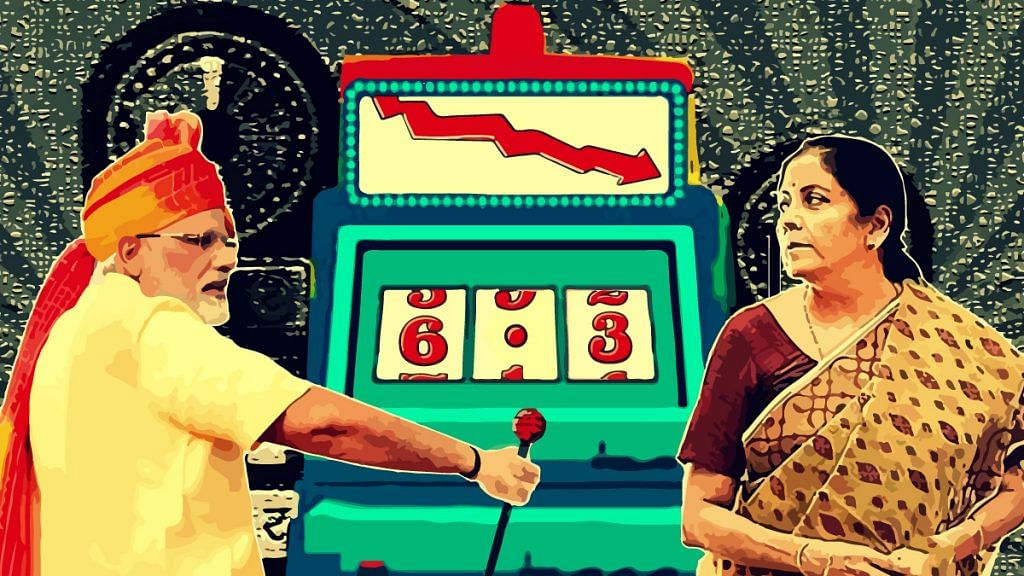The corrections to growth forecasts have come thick and fast, from the Reserve Bank of India (RBI), the World Bank, the International Monetary Fund (IMF), rating agencies, investment banks, and sundry others. Almost all of them now place GDP growth for India this fiscal year at 6 per cent, give or take a decimal point or two. These are seen by most observers as downbeat numbers, given that previous forecasts not long ago were close to or at 7 per cent — in the Economic Survey, RBI reports, and elsewhere. Certainly 6 per cent is a big climbdown from last year’s already sub-optimal 6.8 per cent. We are experiencing the slowest economic growth since 2012-13.
Yet, the forecast of even a modest 6 per cent growth rate for the year looks just now like an essay in optimism, considering that the first quarter has clocked just 5 per cent, and the second quarter brought little by way of good news. Growth would have to be 7 per cent in the October-March period if the year as a whole is to clock 6 per cent. Who would bet on that when, in the world of real numbers, both exports and imports have continued to fall, car sales have continued to slump, and the industrial production index shows yet again a drop in output? For good measure, tax revenue (especially from the tale-telling goods and services tax) lags Budget numbers, corporate results sans the tax break are disappointing, credit flow is poor, fuel consumption trends show a loss of momentum, residential real estate sales continue to plumb the depths, orders for capital goods remain scarce, and the sales of items of everyday consumption have slowed. Even sectors growing rapidly till recently, like aviation and cement, now report little or no growth. It is hard to square all this with the uptick that the forecasters see as being already under way.
But the economic soothsayers who have been polled by the RBI may well be right when they predict a pick-up to 5.8 per cent growth for the July-September quarter, and still better numbers for the current quarter (6.4 per cent) and the next one (7.2 per cent). The secret to their optimistic jump from 5 per cent to 7.2 per cent in three short quarters lies in that familiar statistical quirk: A low base from which growth is measured. For the same reason, reversion to annual growth of 7 per cent or more in 2020-21 should not be seen as unhinged from reality.
Also read: Nobel winner Abhijit Banerjee offers cure to India’s ideology-driven public policy ailment
These numbers are best understood by starting with the post-demonetisation slump in growth, in April-June 2017, to 5.7 per cent. That low base helped the same quarter a year later, in 2018, to report 8.2 per cent growth. This then became the high base that pushed down the April-June number this year, 2019, to 5 per cent. If one irons out these statistical swings, and averages out growth for the same quarter over three years, the figure is 6.3 per cent — unimpressive, but not a number that should provoke so much breast-beating in a slowing world economy!
Do the same exercise for the last three second quarters (July-September, 2017-18-19, including the forecast of 5.8 per cent for this year) and the average works out to 6.4 per cent — signalling no real change. The forecasts for the third and fourth quarters, in comparison, point to a mild uptick, the three-year average quarterly numbers going up to 6.7 per cent and 6.9 per cent in successive quarters. In other words, what the forecasters expect is only a slow revival in the second half of the financial year.
Is even this modest optimism justified? On the strength of the worsening numbers being reported from different segments of the system, perhaps not yet. Nor will a recovery be helped by the fact that the global economy is going through what the IMF calls a synchronised slowdown. But all downturns must end, and a recovery will eventually materialise. So wait for the first half of the next financial year, when this year’s really low statistical base will yield some magical growth numbers. That’s when the government’s PR machine will go into overdrive!
By Special Arrangement with Business Standard
Also read: India’s bad loans crisis is turning into a snatch-and-grab jungle raj
